Baggage Handling eTool

Ramp Area » Manual Loading and Unloading
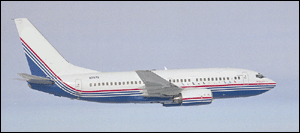
Manual loading or unloading systems exist in narrow-body and some wide-body aircraft. Typically, ramp agents transfer baggage from a cart to a beltloader that automatically moves items to the cargo compartment. Once inside the cargo compartment, ramp agents must move and position baggage while working in cramped spaces. Ramp agents may also manually reposition baggage carts.
Hazards and solutions can be grouped into the following categories:
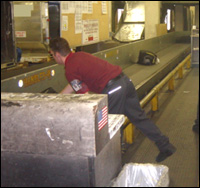
Potential Hazards
-
Handling heavy, large, or oddly shaped baggage requires use of excessive force and awkward postures, increasing the risk of musculoskeletal injury.
-
Handling uneven loads, such as when grabbing two bags of different weights or carrying a single bag with one hand, can lead to uneven muscle exertions and poor postures, making muscles, ligaments, and discs more prone to injury.
- Repeatedly handling baggage can increase the risk of musculoskeletal injuries.
-
Frequent lifting may not allow sufficient recovery time and increase the risk of muscle fatigue
-
-
Lifting a bag by the handle can result in awkward postures and may cause injury if handles break. (Figure 1)
-
Baggage straps getting snagged or caught on a beltloader may cause injury.
-
Falling baggage can cause injury to unsuspecting workers as well as those who try to stop or catch the falling bags.

Possible Solutions
-
Educate agents about proper lifting techniques to increase awareness of good work practices.
-
Perform stretching exercises that help loosen and relax the muscles and joints.
-
Use heavy luggage tags to create awareness of actual bag weights. (Figure 2)
-
Park carts within three to five feet from the beltloaders to minimize carrying distances.
-
Use a hand truck or cart to move large and heavy bags over long distances.
-
Secure or remove baggage straps.
- Ensure that ramp agents do not throw baggage or attempt to catch falling baggage.
- Forces due to acceleration may be two to three times greater than the object's weight.

Potential Hazards
-
Manually positioning baggage carts (sometimes weighing over 1,000 pounds) may require extreme pushing and pulling forces.
-
Parking carts too close to the beltloader can lead to repeated lifting while twisting. Ramp agents may tend to lift and twist instead of moving their feet when a cart is too close to the beltloader.
-
Parking carts too far from the beltloader forces agents to repeatedly carry heavy bags over extended distances. This can be especially hazardous under wet or icy conditions.
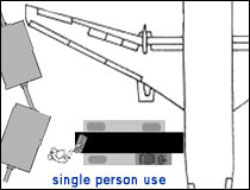
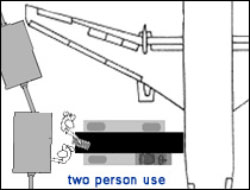
Possible Solutions
-
Educate agents about proper lifting techniques to increase awareness of good work practices.
-
Perform stretching exercises that help loosen and relax the muscles and joints.
- Position carts at least three feet from beltloaders to encourage agents to pick up bags from carts and turn, instead of twist, to take bags to beltloaders.
- If one person is working, the cart should be set at an angle to the beltloader. (Figure 4a)
-
If more than one person is working, the cart should be perpendicular to the beltloader to provide adequate access for both workers. (Figure 4b)
- Heavily loaded carts should not be moved manually. If carts must be moved manually:
- Avoid stepping over the tongue or towbar,
- Unhook and move no more than one cart at a time, and
-
Use enough people to keep pushing forces within recommended limits.
-
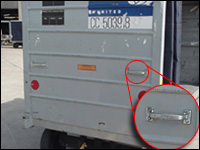
Appropriately designed and installed handles on carts or tongue and towbar can facilitate pushing and pulling tasks. (Figure 5)
Potential Hazards
-
Bending at the waist and twisting to lift bags from a lower shelf of the cart up to the beltloader can cause injury due to awkward postures while lifting and twisting.
-
Reaching away from the body to grab a bag at the back of a cart can cause injury to the low back and can strain other muscle groups. (Figure 6)
-
Elevated and extended reaching above the shoulders to handle a bag on a shelf can cause injury. (Figure 7)

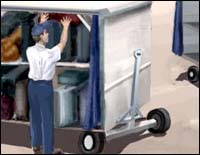
Possible Solutions

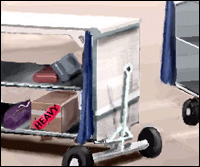
-
Educate agents about proper lifting techniques to increase awareness of good work practices.
-
Perform stretching exercises that help loosen and relax the muscles and joints.
-
Use a two-handed lift, regardless of handle location. (Figure 8)
-
Sort heavy and large baggage to lower positions on the cart. (Figure 9)
-
Avoid stacking baggage above shoulder height.
-
Reduce extended reaches to back of carts.
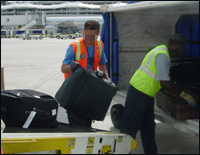
Potential Hazards
-
Positioning the end (closest to the cart) of the beltloader too low may cause agents to bend at the waist when placing or removing baggage. This can lead to unnecessary stresses on the body.
-
Positioning the end of the beltloader too high may cause agents to raise their shoulders or extend their elbows away from their body when placing or removing baggage.

Possible Solutions
- Adjust the end of the beltloader to ensure optimum lifting heights based on loading conditions and the type of cart used. Place belt at a height that will ensure good posture while lifting baggage to and from the belt and baggage cart.
- When unloading the cart, the vertical position of the beltloader should be level with or just below the cart bottom. (Figure 10)
- When taking bags from the beltloader to the cart, raise the belt to at least waist height. This reduces bending and facilitates loading by working with gravity (moving from a higher location to a lower location). (Figure 11)
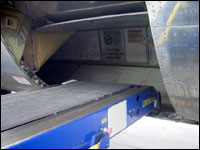
Potential Hazards
-
Positioning the end of the beltloader (near cargo bin) too low forces agents to bend and lift bags up to put them into the cargo bin.
-
Positioning the end of the beltloader too far away from the cargo bin may require agents to reach and pull bags into the compartment.
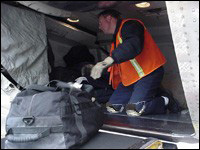
Possible Solutions
-
Position beltloader at the edge of the cargo compartment opening to minimize gaps so agents do not have to reach to access items.
-
Elevate and place beltloader inside the cargo bin when loading so items are deposited close to the agent. This minimizes reaching, pulling, and pushing. (Figure 12)
-
Place beltloader at or below the lip of the cargo bin when unloading so items can be placed on the beltloader using pushing and sliding motions rather than lifting. (Figure 13)
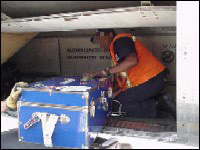
Potential Hazards
-
Handling heavy, awkward, and large bags in a limited space (Figure 14) places the handler in stressful positions that can result in injury.
-
Frequent lifting may lead to insufficient recovery time and muscle fatigue.
-
Performing extended reaches while working in limited spaces can stress the neck and shoulders.
-

Sitting on the edge of the cargo bin while lifting or arranging baggage (Figure 15) causes the handler to twist while lifting or sliding baggage.
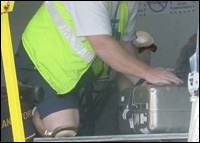
Possible Solutions
-
Educate agents about proper lifting techniques to increase awareness of good work practices.
-
Perform stretching exercises that help loosen and relax the muscles and joints.
-
Alert loading and unloading crews when heavy bags are coming.
- Slide baggage close to the body before lifting.
- Minimize twisting by kneeling at an angle to the belt in the direction of loading.
-
Kneel on both knees when pushing bags or balance on one knee and one foot. (Figure 16)
-
Stack large or heavy bags on the bottom.

Potential Hazards
-
Taking gate-checked baggage by hand from the gate to the cargo bin places stress on the worker's shoulders and back, especially if the bags are large or heavy.
-
Taking strollers, wheelchairs, or other oddly shaped and heavy items up or down loading bridge stairs can be dangerous, especially during wet or icy conditions.
Possible Solutions
-
Use a hand truck or small manual cart to move individual items of baggage over long distances.
-
Use chutes, slides, or mechanical lifting devices.

